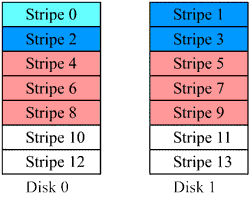RAID 0
RAID 0 shouldn't be even called RAID as it does not provide any redundancy at all. And no redundancy means no increase in data reliability and security. Even so, it is the highest performing RAID level.
The hardware requirements for setting up a RAID 0 array is the least demanding of all RAID levels. It only requires a minimum of two hard disk drives and can use as many hard disk drives as the RAID controller can support. In the case of the Promise FastTrak100, a maximum of four hard disk drives can be used.
The size of the RAID 0 array can be simply calculated using the following equation :
Size of RAID 0 array = Capacity of smallest hard disk drive X number of drives used
So, for an array using two 500 GB drives, one 400 GB drive and one 750 GB drive, the size of the RAID 0 array would be 400 GB x 4 = 1.6 TB. The reason for using the smallest drive capacity in calculating the actual RAID 0 array size is due to the way a RAID 0 array is created.
RAID 0 uses a technique called striping. What it does is create blocks or stripes that are distributed across over all the hard disk drives in the RAID 0 array. Because blocks of data are now spanned across multiple hard disk drives, data can actually be accessed in parallel, delivering a much faster data transfer rate. For optimal performance and efficiency, the hard disk drives used in the array should be of the same brand and model. Let's take a look at the diagram below.
 |
Let's take, for example, a stripe size of 16 KB. Now, File1 with the size of 16 KB is represented by the cyan colour while File2 (48 KB), is represented in blue. Finally, File3 (96 KB), is light red in colour.
As you can see, each stripe is filled up before the next one is used. Okay, let's say we want to read File1. File1 is only found on one drive. Therefore, there would not be any increase in performance as all the data in File1 was read from only one stripe.
However, if we were to read File3 instead, data can be streamed from both drives at the same time. This creates an impression of a much faster hard disk drive, theoretically doubling the transfer rate.
The stripe size used for the array determines the kind of performance of the RAID 0 array. Some users may prefer higher data transfer rates while others might choose to have better I/O performance. Such optimizations are determined by using different stripe sizes. The stripe sizes will be discussed at length a little later in this guide.
On the other hand, using an array of multiple devices increases the chance of the entire system failing due to a problem with one of the RAID drives. This is because each of those drives do not act independently anymore. If one fails, the entire RAID 0 array fails. Thus, their Mean Time Between Failures (MTBF) do not count anymore. The proper MTBF for a RAID 0 setup can be calculated this way :-
RAID Array MTBF = lowest independent drive MTBF / no. of drives used in array
Because RAID 0 does not provide any redundancy, it would be impossible to recover a failed RAID system without a backup. Unlike normal crashes, you will not able to extract any data from the RAID 0 array's drives even though only one of the drives failed. This is because every file had been striped across two or more drives. Therefore, when any one drive fails, chunks from every file will disappear and all files in the RAID 0 array will be unusable.
Support Tech ARP!
If you like our work, you can help support out work by visiting our sponsors, participate in the Tech ARP Forums, or even donate to our fund. Any help you can render is greatly appreciated!
Page |
Topics |
|
|
1 |
|||
2 |
|||
3 |
• RAID 0 |
||
4 |
• RAID 1 |
||
5 |
|||
6 |
• RAID 5 |
||
7 |
|||
8 |
|||
9 |
|||
10 |
|||
11 |
|||
12 |
|||
13 |
|||
14 |
|||
15 |
|||
16 |
|||
17 |
|||
18 |
|||
19 |
|||
20 |
|||
21 |
|||
22 |







 Add to Reddit
Add to Reddit
